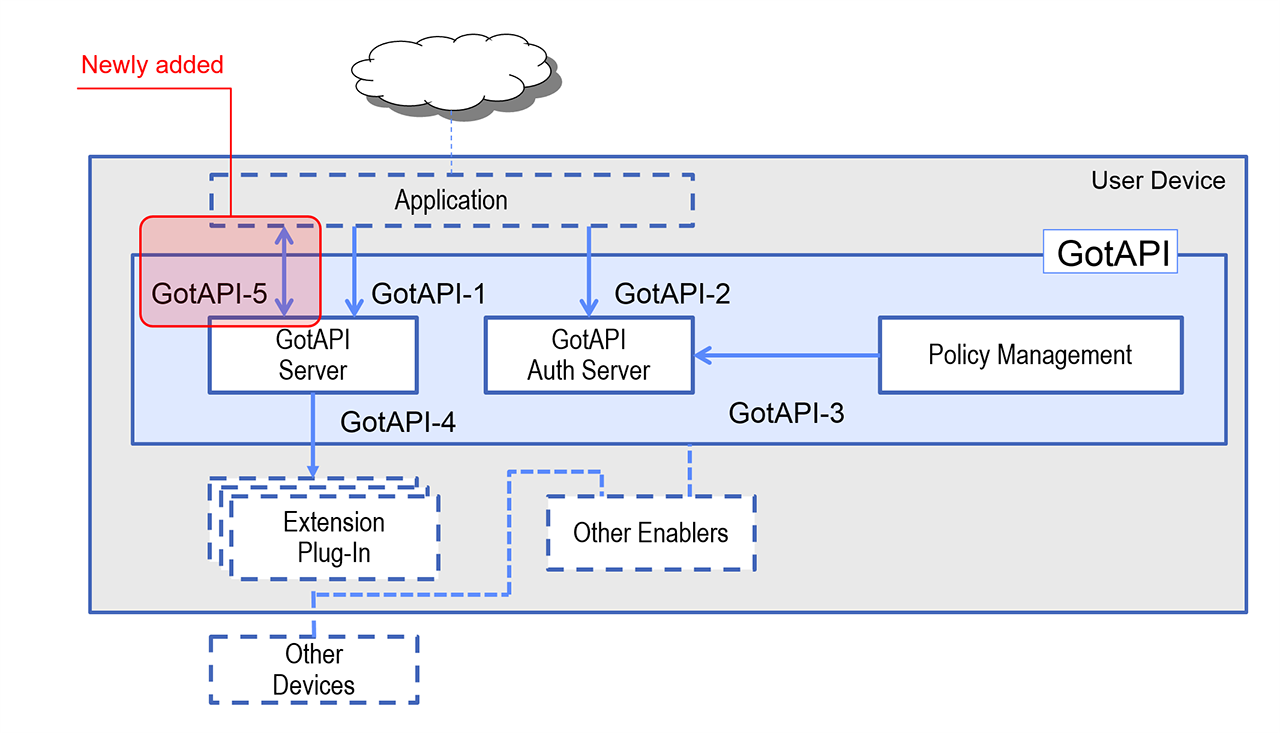...
- Get agreement across participating parties as to what work should be done and where (which SDO) it needs to be done.
- Examine landscape across mobile and automotive environment
- Identify areas of overlap across industry work groups (RVI, W3C, GSMA, 3GPP, OMA, Smart Device Link, Apple CarPlay and Android Auto, OCF, etc…)
- Produce use cases/examples including interaction between IoT and automobile
- Roadmap and proposed timeline of future work needed, for example
- Security-related issues
- Enabler creation or reuse to facilitate development of enhanced services
- Collaborate with additional verticals (environmental, safety, healthcare)
- Deliverables publication to be public and available online
- Reference code-based projects already underway
- Clarify what should be standardized, open source vs. proprietary to encourage interoperability
- Other TBD
2. References
| Reference | Details |
|---|---|
\[GotAPI\] | Generic Open Terminal API Framework (GotAPI), Candidate Version 1.1 – 15 Dec 2015, Open Mobile Alliance, http://technical.openmobilealliance.org/Technical/technical-information/release-program/current-releases/generic-open-terminal-api-framework-1-1 |
| \[DWAPI\] | Device WebAPI-PCH, Candidate Version 1.0 – 19 Apr 2016, Open Mobile Alliance, http://technical.openmobilealliance.org/Technical/technical-information/release-program/current-releases/oma-device-webapi-v1-0 |
| \[OCF\] | The Open Connectivity Foundation (http://openconnectivity.org) |
| \[IoTivity\] | The open source implementation of the OCF speciications (http://iotivity.org) |
| \[RVI\] | Remote Vehicle Interaction open source project (https://github.com/GENIVI/rvi_core) |
| \[VSS\] | Vehicle Signal Specifications (https://github.com/GENIVI/vehicle_signal_specification) |
...
Interoperability standards in data formats and programming interfaces (APIs) in even more essential if non-automotive devices are attached to the "connected cars." Otherwise, consumers need to buy all their home appliances and electronic devices from the car dealer. This model ended with the "car phone" but continues in some way with the limited services available in closed telematics offers by each carmaker.
4.1 Observed Problem
...
5.1 Over-the-air updates
5.1.1 OMA DM (are all of Red Bend's contributions included?)
The OMA-DM protocol is deployed by leading Mobile Network Operators (MNOs) like AT&T, NTT DOCOMO, SoftBank, Sprint, T-Mobile US and Verizon Wireless. The MNOs use the OMA-DM protocol to manage mobile devices on their network. The following are some of the use cases MNOs have deployed:
...
In recent years, with the introduction of the connected car, the term “mobile device” is extended to include the “large mobile device” of the automotive industry. Many car OEMs select to use the OMA-DM protocol to manage the configuration and software of the cars they are building. This enables car manufacturers to capitalize on the full business potential of connected cars by enhancing driver experience with rapid deployment of value-added in-car services, and minimizing costs through improved efficiency and a reduction in recalls.
5.2 Device APIs (move all API info to this section - Elizabeth)
5.2.1 Overview (Alan to edit)
needs to be made generic - not OMA-centric Through OMA enablers focused on device APIs, we can enable Automotive systems to offer API services to apps running in app environments provided by the Auto system. Such API services can enable apps to access vehicle information/services or other connected devices. These OMA enabler APIs are based on the Generic Open Terminal API (GotAPI) \[GotAPI\] enabler framework described in section 6.2.
...
6.1 W3C Automotive Web API (Sanjeev-owner; Alan-editor)
6.1.1 Overview and objective of project...
...
- GotAPI-5: The GotAPI-5 interface enables applications to listen to asynchronous messages from Extension-Plug-Ins via the GotAPI Server using WebSockets.
GotAPI Interfaces
Transport Protocols
6.3 LWM2M
...
6.3.1 Overview
The OMA LWM2M (Light Weight Machine To Machine) protocol provides the capability for applications to communicate and manage IoT devices. LWM2M is based on the IETF Constrained Application Protocol (CoAP) providing communication between a LWM2M Server and a LWM2M Client (where Client is located in a constrained IoT device).
...
- Access control on the specific contents that could be handled remotely by different entities
- Software and firmware Management for applications inside the Client
- Lock & Wipe of the device from misuse
- Connection management for choosing various radio methods by the Client
- Device Capability Management to identify the capabilities existing in the device
- Location of the device
- Connection Statistics concerning communication characteristics over the air
...
6.3.5 Object Registry
The object registry provides a unique way of identifying the necessary and relevant objects. The object registry is maintained by OMNA (Open Mobile Naming Authority). It includes categories for interleaving 3rd party management objects and application objects into the OMNA system from vendors and other standards organizations (for, e.g., IPSO Alliance and oneM2M)
...
)
...
6.5.1 Overview and objective of project...
...
6.5 W3C VSS Standardization
...
OCF has the vision to connect the next 25 billion things
- Automakers want simple interconnection with smart devices.
- Developers want apps to work across car brands and ecosystems.
- End users want secure connectivity and services across devices.
...
6.6.8 Related Links
...
The complete blog is presented here. https://blogs.s-osg.org/osg-ocf-automotive-fortnight/
6.6.2 API's defined
Please focus on expected overall penetration of OSS work in IoT market
6.7 OMA-DM and vehicle security (YAIR N)
6.7.1 Overview and objective of project...
...
7.0 Analysis and recommendations to achieve interoperability
...
Unquestionably, security is a key factor and methodologies under development for protecting and securing private and safety critical information should be the topic of study for another paper in this series.
8. References (Temporary)
- http://www.volkswagenag.com/content/vwcorp/info_center/en/news/2016/07/connected_car.html
- http://fortune.com/2016/07/13/jaguar-land-rover-autonomous-cars-britain/
...
